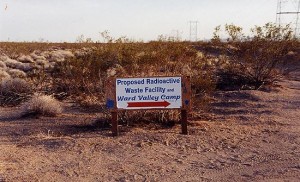By Michael Collins
 The proposed Ward Valley nuclear dump is near death, but how much will taxpayers have to shell out to bury it? That’s the big question after U.S. District Judge Emmet Sullivan’s ruling that the federal government doesn’t have to turn over 1,000 acres of Mojave desert, 19 miles west of the Colorado River, to the state for a radioactive-waste dump for the nuclear industry. US Ecology, which had fought for more than a decade to build and run the dump, said it doesn’t want to appeal Sullivan’s decision, but may if the company doesn’t get what it wants. And that is a government payoff, according to a second lawsuit US Ecology has on file, against Bruce Babbitt and the Department of the Interior, to recover the $50 million it claims to have spent on the dump since 1985, plus lost interest and “lost opportunity” investment revenues. think you are looking at probably in the neighborhood of $300 or $400 million dollars; [that] would have been a normal, successful business return on that kind of investment,” Joe Nagel, president of US Ecology, said this week.
The proposed Ward Valley nuclear dump is near death, but how much will taxpayers have to shell out to bury it? That’s the big question after U.S. District Judge Emmet Sullivan’s ruling that the federal government doesn’t have to turn over 1,000 acres of Mojave desert, 19 miles west of the Colorado River, to the state for a radioactive-waste dump for the nuclear industry. US Ecology, which had fought for more than a decade to build and run the dump, said it doesn’t want to appeal Sullivan’s decision, but may if the company doesn’t get what it wants. And that is a government payoff, according to a second lawsuit US Ecology has on file, against Bruce Babbitt and the Department of the Interior, to recover the $50 million it claims to have spent on the dump since 1985, plus lost interest and “lost opportunity” investment revenues. think you are looking at probably in the neighborhood of $300 or $400 million dollars; [that] would have been a normal, successful business return on that kind of investment,” Joe Nagel, president of US Ecology, said this week.
Eric Glitzenstein, attorney for Committee To Bridge the Gap, says US Ecology’s financial claims are bogus. “An unethical relationship between Governor Wilson and US Ecology is not a basis for getting their money back,” agrees Ward Young of the Bay Area Nuclear Waste Coalition. “There were ample indications of both the project’s illegality and its dangerous impact, and that it should have never gotten off the drawing board.” But Nagel says eleventh-hour negotiations between Interior Secretary Manuel Lujan and former Governor Pete Wilson to jam the dump through in the waning days of the Bush administration may have obligated the feds to US Ecology.
Nagel also says he has initiated settlement talks on the buyout issue with Secretary of the Interior Bruce Babbitt and Governor Gray Davis. Among the options: negotiating the sale of US Ecology’s dump license to another company — or repealing the 1980 federal law mandating that California build a dump of its own. Then, Nagel says, the state’s goo can be shipped to US Ecology’s dump in Richland, Washington. What a great idea: US Ecology is responsible for four leaking dumps around the country, including the Richland site, where regulators have discovered elevated levels of tritium (i.e., radioactive hydrogen) in the soil at depths of 85 feet. History note: In 1960, the company began dumping 55-gallon drums of goo near the Farallon Islands, 30 miles west of San Francisco; a quarter of the drums leaked, according to the Environmental Protection Agency. Hmm: backroom deals, pollution, legal threats — sounds like a perfect corporate-welfare candidate to us. US Ecology has 60 days from Judge Sullivan’s March 31 decision to file an appeal.












Recent Comments